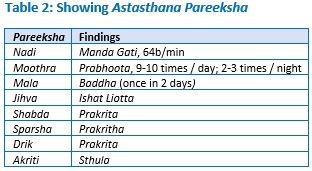Effective management of newly diagnosed case of Prameha with Vasanthika Vamana - A single case study
Keywords:
Vasanthika Vamana, Diabetes mellitus, Prameha, Rutu shodhanaAbstract
Diabetes mellitus is the group of metabolic conditions with constant hyperglycaemia results from defects in insulin production or uptake. Type 2 Diabetes is the most common reason for hyperglycaemia mainly affecting people around age of 40 with lack of exercises and sedentary lifestyle. The increase in incidence of disease and its easy growing complications have become threat to healthcare sector even after the discovery of various hypoglycaemic agents and synthetic insulin. These medicines with long term use are reported to have hazardous side effects. In Ayurveda similar condition has been mentioned under the disease spectrum of Prameha. The line of management of Prameha is to aim at the control of hyperglycaemia along with removing the root cause of the disease. Samshodhana is the line of treatment mentioned for the treatment of Prameha and proper Rutu Shodhana will help to get rid of many Santharpanotha Vyadhis as they do timely elimination of vitiated Dosha. The purpose of this study to evaluate the efficacy of Vasanthika Vamana in Diabetes mellitus in preventing and curative way. In present study, Vasanthika Vamana Karma proved as best treatment in controlling subjective symptoms and blood sugar levels.
Downloads
References
DL Kasper et al. 19th edition, Harrisons Manual of medicine, Endocrinology- Diabetes mellitus, MC Graw Hill Education, 2016, P904.
https://www.diabetesresearchclinicalpractice.com/article/SO168-8227(19)31230-6/fulltext.
Tao Z, Shi A, Zhao J. Epidemiological perspectives of diabetes, Cell Biochem Biophys 20015;73:181-5.
DL Kasper et al., 19th edition, Harrisons Manual of Medicine, Endocrinology - Diabetes mellitus, MC Graw Hill Education, 2016, P905-6.
Acharya YT (ed.), Susruta Samhita of Susruta with the Nibandhasangraha Commentary of Sri Dalhanacharya and the Nyayachandrika Panjika of Sri Gayadasacharya on Nidanastana, Nidana sthana 32nd chapter, 6th verse Varanasi: Chaukhamba Surbharati Prakashan, 2014, Pn.290.
Acharya YT (ed.), Charaka Samhita of Agnivesha elaborated by Charaka and Drdhabala with Ayurveda Dipika commentary by Sri Chakrapanidatta, Nidana sthana 4th chapter 7th verse, Varanasi: Chaukhamba Surbharati Prakashan, 2014, pn.212.
Acharya YT (ed.), Charaka Samhita of Agnivesha elaborated by Charaka and Drdhabala with Ayurveda Dipika commentary by Sri Chakrapanidatta, Nidana sthana 4th chapter 9 verse, Varanasi: Chaukhamba Surbharati Prakashan, 2014, pn.213.
Acharya YT (ed.), Charaka Samhita of Agnivesha elaborated by Charaka and Drdhabala with Ayurveda Dipika commentary by Sri Chakrapanidatta, Chikitsa sthana 6th chapter 15th verse, Varanasi: Chaukhamba Surbharati Prakashan, 2014, p446.
Acharya YT (ed.), Susruta Samhita of Susruta with the Nibandhasangraha Commentary of Sri Dalhanacharya and the Nyayachandrika Panjika of Sri Gayadasacharya on Nidanastana, Chikitsasthana 12th chapter 4th verse, Varanasi: Chaukhamba Surbharati Prakashan, 2014, P454.
Acharya YT (ed.), Susruta Samhita of Susruta with the Nibandhasangraha Commentary of Sri Dalhanacharya and the Nyayachandrika Panjika of Sri Gayadasacharya on Nidanastana,chikitsa sthana 11th chapter, Varanasi: Chaukhamba Surbharati Prakashan, 2014, P452.
Paradakara HSS (ed.), Astanga Hrdaya of Vagbhata with the commentaries Sarvangasudara of Arunadatta and Ayurvedarasayana of Hemadri, Nidanastana 10th chapter 18-19th verse, Chaukhamba Sanskrit Samsthan, Varanasi, 2016, P504.
Acharya YT (ed.), Charaka Samhita of Agnivesha elaborated by Charaka and Drdhabala with Ayurveda deepika commentary by Sri Chakrapanidatta, Sutrasthana 16th chapter 21st verse, Varanasi: Choukamba Surbharati Prakashan, 2014,P97.
Paradakara HSS (ed.), Astanga Hrdaya of Vagbhata with the commentaries Sarvangasudara of Arunadatta and Ayurveda Rasayana of Hemadri, Sutrasthana 4th Chapter, 35th verse, Chaukhamba Sanskrit Samsthan, Varanasi, 2016, P59.















